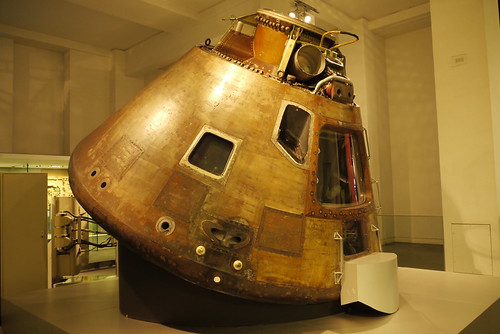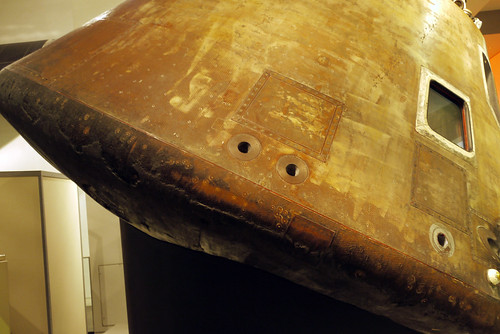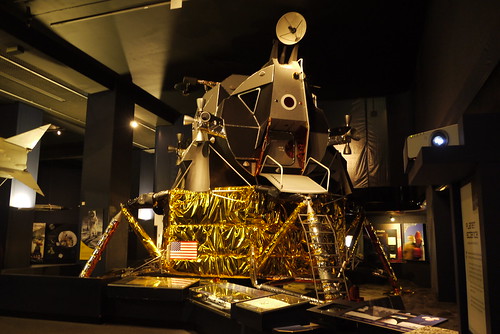One of the exhibits in the London Science Museum is the command module from Apollo 10. It is quite fascinating to see it in person rather than in black and white on a television screen. The scorch marks caused when re-entering the earth’s atmosphere are distinctly visible.
Apollo 10, carrying astronauts Thomas Stafford, John Young and Eugene Cernan, was launched in May 1969 on a lunar orbital mission as the dress rehearsal for the actual Apollo 11 landing. Stafford and Cernan descended in the Lunar Module to within 14 kilometres of the surface of the Moon, the closest approach until Neil Armstrong and Edwin ‘Buzz’ Aldrin in Apollo 11 landed on the surface two months later. The craft, which had the call sign ‘Charlie Brown’, travelled approximately 500,000 miles (800,000 km) during the eight-day mission and exceeded 24,790 mph (39,887 km/h) on its return to Earth, faster than any other crewed vehicle before or since.
Housed in a different part of the museum is a full sized replica of the Apollo 11 lunar module that landed the first humans on the moon in July 1969:
The Eagle has landed – Apollo 11 was the first mission to land people on the moon. It’s lunar module, nicknamed, Eagle transported Neil Armstrong and Buzz Aldrin to the moon’s surface while Michael Collins piloted the command module in lunar orbit.
This full-sized replica of the lunar module shows the lower ‘descent’ stage, with a rocket engine (just visible underneath) that slowed the module to a safe landing, plus storage space for experimental equipment to use on the moon. The upper ‘ascent’ stage included the crew’s cabin and another rocket engine that blasted it off from the top of the descent stage when the mission was over. The descent stage was left behind on the moon.*
*Information from a signboard next to the lunar module











If either of those vehicles – and especially the ‘lander’ – were seriously considered as a conveyance on our roads (with added wheels of course) they would not pass even the most lax saferty regulations. You could poke a hole in the side of the lander craft with a pencil and a sneeze. And one dreads to think of what would happen if a cyclist leaned on it at the traffic lights.
The command module looks rather sturdy and robust close up which is more than can be said for the landing module. The landing craft looks very flimsy and rather like Blue Peter craft project!
Wonderful set of pictures of the module from Apollo 10 and the replica of the lunar module Cherie… i would love to have had the chance to see and photograph these… thanks for sharing it with us….peter:)
They were a bit of a challenge because the lighting in the museum is very dim.
Now that is seriously fascinating. Wondered about full size but you say it is.
I wish I had photographed more of the information boards. They gave further information on the construction. I thought it would be on the Science Museum website but sadly it is not.
Whilst looking for the information I came across a website link that I lost many years ago. It gives a little bit of information about how the model came about, but no technical information.
Cherie, What an interesting exhibit–I always find “space” interesting. We have the second largest museum of space objects in Hutchinson, Kansas ( NASA, down in Houston is first). It is a fascinating place to visit and I always come away in awe of what we have done and where we have gone. Hope all is well–I have been so busy with grandchildren and summer activities that I have not been making the rounds to see everyone’s lovely blog. Take care. Mickie
It sounds like you have been having a fabulous time with your grandchildren. These time are precious and to be captured whenever possible
I thought at first when I saw the title that you were planning a trip to the moon
When you see the equipment used for this trip, it either seems difficult to believe or an awesome achievement.
Now that would be a trip and a half.
The lunar module didn’t look real, it looked like a toy.